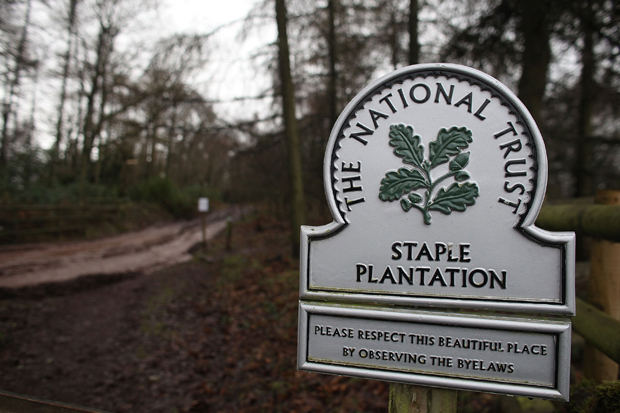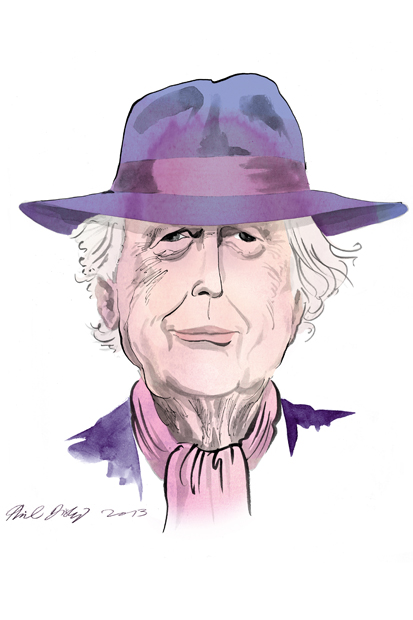Broadhaven Beach in Pembrokeshire was once a sublime combination of the works of nature and man. The broad, deep, sandy bay is flanked by towering limestone cliffs. Two hundred years ago, a stream leading to the sea was dammed by Lord Cawdor, the then owner, to form the Bosherston Lily Ponds.
Enter the National Trust, owners of the estate since 1976. Now the spot where the lakes meet the sea is marked with a bright purple National Trust sign, saying,
Return to the start,
a new path you’ll take
Its rocky in places,
don’t fall in the lake.
Perhaps it’s better in the Welsh translation, also featured on the purple sign. Dear God, I hope it’s more literate.
The sign sums up all that’s terrible about the National Trust — and our libraries, museums and galleries. They are being infantilised by the zealous crusade to make them accessible to people who don’t want to go there.
There are more than four million National Trust members: by far the biggest institution of its kind in the world. It dwarfs the membership of all our political parties put together. In other words, the British already know about the National Trust. They don’t need to be told how wonderful it is; to be spoon-fed its beauties like a baby; or to be warned not to fall in a lake.
They already love the trust’s exceptional houses and landscapes. But those landscapes are now scarred by pointless signs like the Broadhaven horror. And the trust does its best to play down its country houses — Britain’s greatest artistic contribution to the world.
In that famous 1988 advert, the Victoria & Albert museum described itself as ‘an ace caff with quite a nice museum attached’. At least it admitted to the museum. These days, the National Trust wants to ignore its incredible houses; and become a smashing playground for the kids to get all muddy in.
On the ‘Big issues’ page on its website, the trust proudly declares: ‘Most of the work we do is affected by wider global issues, which is why our interests extend far beyond just bricks and mortar.’ Those big issues are ‘Energy saving projects’, ‘Natural Childhood’, ‘Land use & planning’, ‘Transport’ and ‘Ash dieback’. So forget about the single greatest collection of buildings in the world, then.
The trust is a victim of the national accessibility disease: partly linked to getting public money; partly to the grand dumbing-down exercise of modern life.
Have you been to your local library recently? I’m amazed cartoonists still do pictures about grouchy librarians, telling people to keep quiet. Libraries are now largely places to chat and surf the internet. Cardiff’s Central Library has concerts every Saturday. Newcastle’s City Library has a crèche and the Library of Birmingham has an entrepreneurs’ club. Libraries hold Baby Bounce and Rhyme sessions, where tots play with drums while singing nursery rhymes — try reading a book in that din.
In last month’s Public Libraries News, an editorial admitted that ‘Public librarians, perhaps in the reaction to the stereotypical “shush” image, have sometimes gone out their way to be louder and more energetic and, in doing so, have alienated some of its clientele and core audience.’
Brian Ashley, director of libraries for the Arts Council, was enraged, saying, ‘It’s all about the age-old stereotype of libraries as a place where some forbidding person tells you to “shut up” or “shhhh”, and it’s frankly something that most of us who work in libraries would like to consign to history.’
That may be true of noise-loving librarians — not for most people who actually visit libraries. But then accessibility has never been about regular visitors to libraries or National Trust houses. It’s about desperately luring other people to places they don’t want to visit — by destroying those places, by removing the silence and beauty that first made them attractive.
For God’s sake, libraries are free! The National Trust’s countryside and coast are almost entirely free for non-members — on the whole, you only pay for car parking and house-entry fees. How much more accessible can you get?
But the desire to appeal to people who don’t want to visit becomes all-consuming. The millions who appreciate silence and beauty without signage have their pleasures spoilt, in order to appeal to people who don’t appreciate these things.
Or don’t appreciate them yet. We all gradually learn to be grown up and like serious things — that doesn’t happen if public culture is permanently simplified and over-explained for everyone, at all ages.
I was bored by libraries as a teenager. Shamefully, I was even bored by the Bodleian Library when I was at university, seeking any excuse to join pals for drinks in the King’s Arms. Now I spend half my life in the London Library — and love its carefully protected regime of silence and seriousness. I wouldn’t appreciate the London Library, and its rules, half so much if I hadn’t been forced to follow the Bodleian’s rules as a bored teenager.
Even at university, I didn’t want to be patronised: I expected serious places to be serious. I realised the Bodleian was the place to do serious, if sometimes dull, work. And the King’s Arms was the place to chat. Once the Bodleian — still, thankfully, a serious, quiet place — becomes the King’s Arms, it loses its point.
But now museum and gallery curators — as well as the BBC — are falling over themselves to extract the seriousness from once-hallowed institutions to make them more accessible.
Radio 3 is packed with lowbrow brainteasers, trailers, B-list celeb interviews and soul-destroying jolly handovers between presenters. Kensington Palace — once the finest set of late -17th century rooms in London — has become a multimedia show, the panelling echoing to the sound of desperate actors imitating 1690s courtiers.
At Dover Castle, English Heritage invites you to ‘meet members of King Henry II’s royal court. Come face to face with the King himself, Prince John and the court jester — Roland the Farter!’
Forgive me if I don’t laugh at Roland’s fart gags. I’m too busy weeping for the death of serious public culture.
Got something to add? Join the discussion and comment below.
Get 10 issues for just $10
Subscribe to The Spectator Australia today for the next 10 magazine issues, plus full online access, for just $10.
Harry Mount is the author of How England Made the English (Viking).
You might disagree with half of it, but you’ll enjoy reading all of it. Try your first month for free, then just $2 a week for the remainder of your first year.














Comments
Don't miss out
Join the conversation with other Spectator Australia readers. Subscribe to leave a comment.
SUBSCRIBEAlready a subscriber? Log in